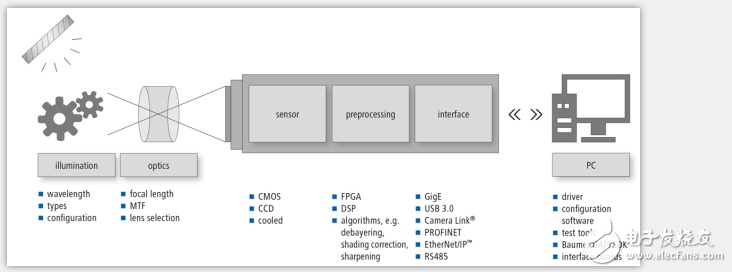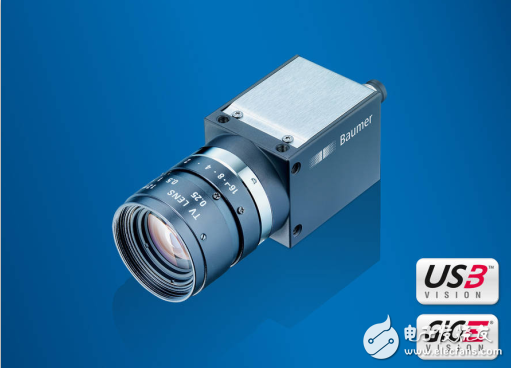Nowadays, artificial intelligence is known as the new engine of economic development, and visual technology as one of the core technologies of artificial intelligence is indeed on the rise. It is so popular that all companies related to industrial automation do not engage in visual technology or products. I am ashamed to say hello to others".
However, with the booming market, in stark contrast to this is the fierce price competition of domestic industrial cameras in general, the hardships of employees in the machine vision industry, especially technology-led vision companies, whose engineers are either debugging at the customer’s site or at On the way to customer debugging, is such a pay and return really proportional? So, working in the machine vision industry is really "I guessed the beginning, but didn't guess the ending." Of course, it's too early to say the ending, it's on fire!
Fire returns to fire, but Marx has long taught us to "see the essence through the phenomenon." In such a hot market, we must think about why the price competition of industrial cameras is so fierce? The price of any 5 million CCD camera has dropped by more than 50% compared to 5 years ago. It's miserable! If industrial cameras are really valuable for high-end manufacturing.
Utility geometry?To clarify this problem, we must first clarify the two most basic concepts, the first is what machine vision is, and the second is what is an industrial camera. The definition is clear, in order to avoid detours. Looking through a lot of literature, I feel that the definition of AIA is quite concise and clear. First of all, machine vision (MV) refers to "for all industrial and non-industrial applications that combine hardware and software, providing operation guidance for equipment based on image acquisition and processing functions" reference [1]. The industrial camera refers to "an imaging device used in a machine vision system. The imaging system includes an imaging sensor chip and various electronic-based functions that convert the visual image of an object into electronic pulses" reference [2]. Sorry, the level of translation is like this, so let's watch it first.
Think about it carefully. In fact, these two concepts convey very important information. In the final analysis, machine vision is an application-oriented technology, which is driven by market and application requirements. Machine vision itself requires a complex hardware and software system. Support, which includes the customer's specific application requirements, software, industrial computers, industrial cameras, lenses and light sources. Please refer to Figure 1 for the schematic diagram of Baumer.

The picture conveys two signals. First, the core value of industrial camera products is not how low their price is, or how much money they save for customers, but as a key imaging technology and image processing software. The hardware carrier can bring much utility or value to solving customer problems and applications. Second, if you want to sell or market industrial cameras, if you only understand low-cost competition and don’t have a deep understanding of customer needs, we can say that this is irresponsible, at least for customers.
In terms of its effectiveness has not been maximized. So, what is the most direct manifestation of the utility of industrial cameras? Excellent image quality? Excellent signal-to-noise ratio? High frame rate and high resolution? In fact, for industrial cameras, these are not matters, otherwise they are really not qualified to call them industrial cameras. The most important thing is actually very simple, it must be stable! stable! stable! Sorry to say the important thing three times. Of course, to do this, companies must avoid vicious competition and have the ability and financial resources to continuously invest in product research and development.
Why do you say that? To put it bluntly, if an industrial camera works continuously for 24 hours a day, it does not have the most basic problems such as dropped lines and frame loss, and it can be perfectly compatible with other electrical equipment on site, which will undoubtedly greatly improve the inspection efficiency of machine vision. Engineers will save a lot of time for more valuable technology development, instead of "always on the road", when machine vision machines are efficiently transformed into real productivity, "artificial intelligence becomes the new engine of economic development" will also disappear It is a dream.
Of course, as an application-driven product, it has to be admitted that the price elasticity of demand for industrial cameras in certain industries is very large. If there are not too many requirements for the frame rate and stability of industrial cameras, the image noise will be more or less. Without affecting the detection, the industry will inevitably become a red sea. With the emergence of a large number of homogeneous substitutes, users are more concerned about how much money can be saved and short-term rapid gains. The final outcome must be price convergence. To do these industries, I'm sorry, only those who can play.
However, when we return to the defining essence of industrial cameras and machine vision, we will find that there are always some industries that recognize the value of industrial cameras themselves as the carrier of technology and applications, and are willing to use them, that is, through the consumption of such types of products. The degree of satisfaction generated by goods and services, to pay higher prices. As an industrial camera provider, we must also think about how to maximize the utility of industrial cameras to customers in the industrial field to gain recognition. Let’s take the Baumer industrial camera as an example. We’re actually climbing the peak all the time (this is definitely mountain climbing, the Baumer flag has reached the highest Manaslu peak at 8163 meters above sea level). As far as the product itself is concerned, Baumer industrial cameras currently use mainstream CMOS sensors, but they continue to stay close to customers in terms of product features and function development, and have a deep understanding of customers' demands for industrial applications. As far as industrial sites are concerned, we found that there are several main features: 1. The environment is complex, and many sites need to consider how industrial cameras work stably under conditions such as humidity, dust, and strong electromagnetic interference. 2. According to different application requirements, industrial equipment should consider the camera's power supply mode, compatibility with other devices (such as PLC, PC), camera interface mode, compatibility with client software, and so on. 3. The working method of the camera needs to consider the specific state of the detected object, in particular, a deep understanding of the real demands behind the customer's detection requirements, how to control the camera for high-speed motion shooting, and how to achieve stable and trouble-free shooting.
First of all, in terms of protection level, Baumer industrial cameras have developed a wide temperature camera with protection level IP67 for customer applications. The working environment temperature can reach -40 °C to +70 °C, and the camera has an integrated temperature sensor. Monitor the camera temperature in real time. In addition, this series of cameras is specially tested for the harsh environment of the scene, and can withstand up to 100g of shock and 10g of vibration. It is really "Let you abuse me thousands of times and I will treat you like first love".

Secondly, for the industrial site power supply, Baumer uses a wide voltage power supply of 8-30V DC, and the camera trigger uses a filter design such as debouncer to ensure that the camera is not interfered by the site and can stably receive the trigger signal. In order to ensure the temperature of high-precision measurement data, all Baumer camera sensors are packaged on a heat dissipation bracket. Good heat dissipation can ensure that the noise of the chip is low, and the time drift of the data is well controlled.

Third, for particularly demanding inspection requirements, for example, Baumer released a series of products with the shortest exposure time of 1 us based on the SONY Pregius chip, ensuring the sharpness and contrast of high-speed moving objects. For big data transmission, Baumer has developed a 12 million resolution camera based on a 10GigE interface, with a maximum frame rate of 335fps and 2GB of storage inside the camera. Aiming at the fire's unacceptable 3D applications, Baumer also introduced a 3D camera based on FPGA programming, which has a dedicated pre-installed program for laser triangulation. In this way, the focal point of the laser line can be positioned with sub-pixel accuracy in the camera, so that only the contour data is transmitted, thereby greatly reducing the amount of data that needs to be transmitted. With a resolution of up to 12 million pixels, a line width of 4K and a distribution rate of more than 2.5 kHz at 128 lines, the camera can reliably identify the smallest deviations even at high processing speeds.
In short, what we have done is just trying to maximize the utility of industrial cameras in machine vision. At a larger level, we will contribute a meager effort to China’s advanced manufacturing. At a smaller level, we hope that the Baumer industrial camera can be used. Bringing a pleasant experience to users, and no longer letting engineers consume energy and time due to the instability of the hardware, these are huge costs for enterprises. Therefore, we believe that there will be a day when our beloved visual engineers will no longer be so hard, and there will be less buzzing of industrial computers in their ears, and there will be no need to face the gloom of the screen all day long and sweat; When the bird entered the forest, what he looked up was the smoky smoke from the house.
Shenzhen Guan Chen Electronics Co., Ltd. is a High-tech enterprise that integrates R&D, design, manufacture of computer peripheral products.The products include Thunderbolt Docking Station,USB Docking Station,USB Hubs,USB Adapter, Thunderbolt Cable , SSD Enclosure , HDD Enclosure . Our company adheres to the principle and motto of Being sincere, Responsible, Practical to meet the needs of markets and customers with high quality technology and management. We commit ourselves to new product development and also stress the exploring of international markets.
Our company owns a professional production team and establishes strict quality control standard, so we can provide high quality products and service for customers. We have Grapgic designer,3D Deisnger and Electronic designer to provides professional OEM/ODM service. Our factory covers an area of 1,000-2000 spare meters, which houses 100-200 workers, so our production capacity reaches 50,000 pieces every day.With more than 10 engineers focusing on research and development, our private model attracts much among different markets. Over 100 new designed models are released per year.There are also 3 lean production lines to fullfill small quatity orders production for variety of models.
Our Thunderbolt 3 Docking Station has passed thunderbolt certified by intel and apple.Our product also all can meet with CE, RoHS, UL, FCC and other related certification.And our factory also meets legal environmental standards ensuring your order is delivered. We have a very good reputation at home and abroad. Our products are mainly exported to Europe, USA and Southeast Asia. We provide one-stop-service and promote customers achieve rapidly development. Customer comes First, Quality Ranks First, and Reasonable Price.Guanchen will be your faithful partner from China.
Type C To Network Adapters,Type-C To Network Hubs Rj45 Adapter,Network Hubs Rj45 Adapter,Usb-C To Gigabit Network Adapter
Shenzhen GuanChen Electronics Co., Ltd. , https://www.gcneotech.com